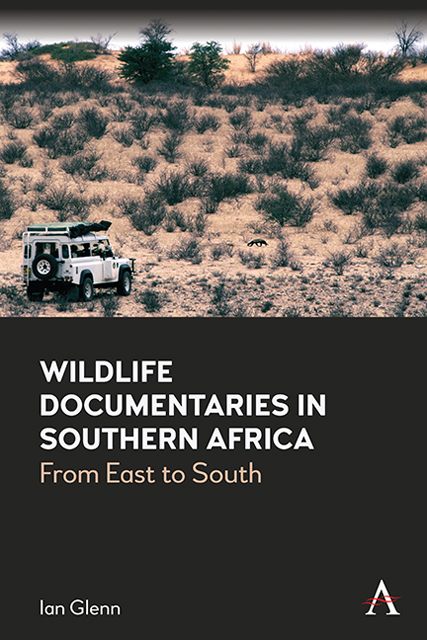Book contents
- Frontmatter
- Dedication
- Contents
- List of Figures
- Acknowledgements
- Introduction
- Chapter 1 What do the Critics Say?
- Chapter 2 A Theoretical Coalition?
- Chapter 3 Gone South: From East to Southern Africa
- Chapter 4 Private Lodges, Infrastructures and Guides
- Chapter 5 Going South: The Results
- Chapter 6 The Early History
- Chapter 7 The South Africans Enter the Game
- Chapter 8 Michael Rosenberg and Partridge Films
- Chapter 9 David and Carol Hughes
- Chapter 10 The Bartletts in the Namib, the Liversedges in Botswana
- Chapter 11 John Varty, Elmon Mhlongo and Londolozi
- Chapter 12 Richard Goss and Kim Wolhuter
- Chapter 13 Dereck and Beverly Joubert
- Chapter 14 Other Major Contributors
- Chapter 15 Going Live: Africam And Wildearth
- Chapter 16 Craig and Damon Foster
- Chapter 17 Must Love Animals?
- Chapter 18 The Social Turn
- Chapter 19 The Future of the Genre
- Chapter 20 The Influence of the Genre
- Conclusion
- Filmography
- Plates
- References
- Index
Chapter 4 - Private Lodges, Infrastructures and Guides
Published online by Cambridge University Press: 10 January 2023
- Frontmatter
- Dedication
- Contents
- List of Figures
- Acknowledgements
- Introduction
- Chapter 1 What do the Critics Say?
- Chapter 2 A Theoretical Coalition?
- Chapter 3 Gone South: From East to Southern Africa
- Chapter 4 Private Lodges, Infrastructures and Guides
- Chapter 5 Going South: The Results
- Chapter 6 The Early History
- Chapter 7 The South Africans Enter the Game
- Chapter 8 Michael Rosenberg and Partridge Films
- Chapter 9 David and Carol Hughes
- Chapter 10 The Bartletts in the Namib, the Liversedges in Botswana
- Chapter 11 John Varty, Elmon Mhlongo and Londolozi
- Chapter 12 Richard Goss and Kim Wolhuter
- Chapter 13 Dereck and Beverly Joubert
- Chapter 14 Other Major Contributors
- Chapter 15 Going Live: Africam And Wildearth
- Chapter 16 Craig and Damon Foster
- Chapter 17 Must Love Animals?
- Chapter 18 The Social Turn
- Chapter 19 The Future of the Genre
- Chapter 20 The Influence of the Genre
- Conclusion
- Filmography
- Plates
- References
- Index
Summary
Introduction
As previous chapters have shown, filming wildlife in South Africa was difficult, in part because of the regulations and terrain of the Kruger Park, which for much of the period was the only place in South Africa where free-roaming Big 5 game were found. Places such as the Kalahari and the Okavango offered more obvious rewards. As Kim Wolhuter put it after filming for the first time in the Serengeti in 2021: ‘My first time to east Africa. Was insane. Now I see why all those international crews don’t want to film in our bushveld, cos they’ve been spoilt with those open plains’ (Wolhuter, 20 November 2021).
This chapter analyses how the growth of private eco-tourism lodges around the Kruger Park, and particularly in Mala Mala and the Sabi Sand, turned the bushveld into an area where people could film successfully, overcoming the difficulties of the local terrain. The first part of the chapter explores the development of the private lodges; the second part the infrastructural and technological developments there that forwarded both tourism and filming; the third part the rise of career guides and their importance; the fourth part the importance of habituated animals. In conclusion, it considers the implications of these developments and which films they affected.
The Growth of Private Lodges
Many of the farms adjoining the Kruger Park’s western boundary were originally hunting farms owned by wealthy white businessmen. This area had originally been part of the Sabi Game Reserve which included the current Kruger Park. In 1926, the National Parks Act was passed and the land to the west sold off to private owners – mainly for hunting. In 1961, the Kruger Park, concerned about possible foot and mouth disease and the effects of hunting on its western boundary, fenced it in. In 1962, Mala Mala moved from hunting to photographic tourism and started the development of luxury safaris. In 1993, when hunting in the Sabi Sand had ended, the fence was removed, allowing for the free movement of game across the whole area.
In the neighbouring Sabi Sand Reserve (often referred to as Sabi Sands), hunting still continued on many of the farms.
- Type
- Chapter
- Information
- Wildlife Documentaries in Southern AfricaFrom East to South, pp. 45 - 56Publisher: Anthem PressPrint publication year: 2022

